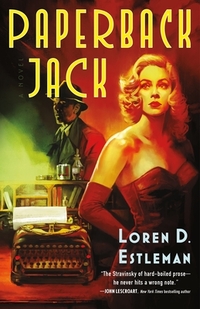Paperback Jack by Loren D. Estleman
 Friday, November 11, 2022 at 5:35AM
Friday, November 11, 2022 at 5:35AM 
Published by Forge Books on November 15, 2022
Paperback Jack is a tribute to the writers who published their original creations in paperback (as opposed to writers whose books appeared in hardcover before they were republished in paperback) when paperbacks were first being widely distributed. As Loren D. Estleman tells the story, pulp fiction magazines that were popular before the war gave way to paperback originals in the post-war years. Many pulp writers made the transition to paperbacks because that’s where the money was. New writers also seized the opportunity of mass readership that paperbacks made available.
Estleman cites his sources for the history of paperback publishing in a Recommended Reading section at the end of the novel. He also gives a shout out to writers like David Goodis, John D. MacDonald, Harlan Ellison, Donald Hamilton, and Leigh Brackett, important and gifted writers who primarily published their original novels and story collections in paperback. He left Philip K. Dick off the list, but I’ll forgive him. Dozens and dozens of outstanding writers wrote paperback originals during the post-war years.
History lessons aside, Paperback Jack is a work of fiction. Before the Second World War, Jacob Heppleman wrote stories when he wasn't working in his day job. He sold a few, then wrote a crime novel that was serialized over five issues of a pulp magazine. The novel caught the attention of an agent who persauded Heppleman to retain his services.
Heppleman is drafted before his agent can sell his novel. He comes home to an America that has abandoned the pulp market. Preferring the life of a writer to a job that made him listen to a boss, Heppleman tries to buy a slick portable typewriter from a pawnshop owner. When Heppleman attempts to negotiate a better price, the shop owner insults his war service. That night, Heppleman gets drunk, tosses a brick through the shop window, and steals the typewriter.
Heppleman writes a war novel and tracks down his old agent, who tells him that the public has had enough of war. Paperback crime novels with lurid covers (as well as westerns with lurid covers and comic books with lurid covers) are the new rage. Heppleman is skeptical until he learns that while he was overseas, the agent sold his crime novel to a paperback publisher for a hefty sum.
The publisher is focused on brand identity rather than literary quality. Heppleman has reservations about writing books that will be marketed with lurid covers, but he needs to make a living so he signs a book contract. He pitches a novel about a reformed fence. To gather accurate background information, Heppleman gains an introduction to an actual fence who expects a share of the profits (including movie royalties) if the book does well.
The publisher changes Heppleman’s name to Jack Holly, has the company’s best artist paint a lurid cover, and Heppleman is on a reluctant road to success. The plot takes Heppleman through his writing career, a courtship and marriage, a friendship with a gay cover artist, testimony before a congressional committee that puts on a show at the expense of comic books and paperbacks with lurid covers, and a conflict with the fence. The novel’s ending flashes forward to give Heppleman a chance to be grateful for an industry that allowed him to make a living.
Estleman always writes with economy and purpose. As his publisher says of Heppleman, Estleman is incapable of writing a bad sentence. He’s the kind of prolific writer whose books would have been published as paperback originals in the 1950s, although his work began in the 1980s and Paperback Jack is currently published in hardcover. I wouldn’t call the cover of Paperback Jack lurid (it’s missing blood and a dead body while the busty blonde only bares her shoulders), but it does suggest a tame version of a cover from the golden age of paperback originals.
Heppleman struggles to maintain his independence and decency while respecting the practical advice of his wife, who understands that raising a child requires at least a modest income. Heppleman, his wife, and the artist are all likable characters. The story is entertaining, but its true value lies in Estleman’s reminder that the post-war explosion of paperback originals made an important contribution to the history of American literature.
RECOMMENDED
 TChris |
TChris |  Post a Comment |
Post a Comment |  Loren D. Estleman in
Loren D. Estleman in  Thriller
Thriller
Reader Comments